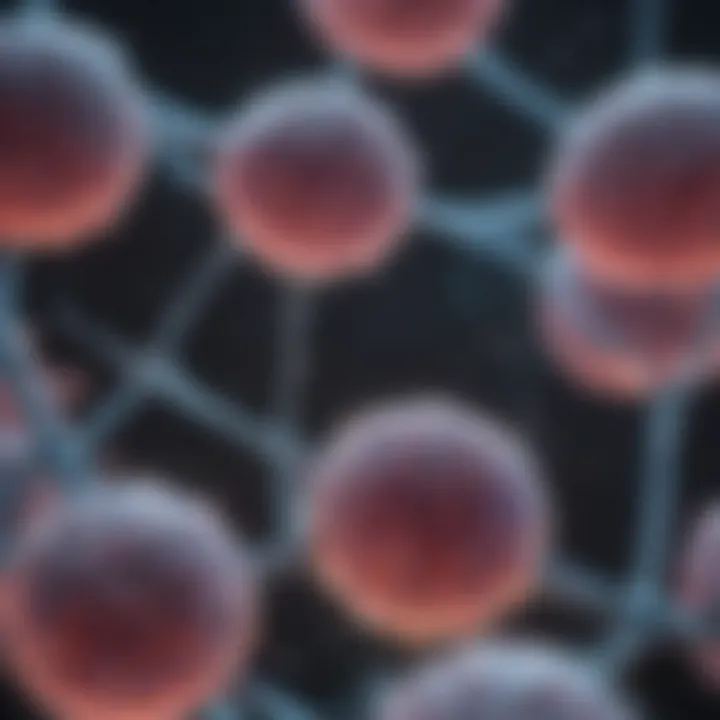Genetically Modified Embryos: Science and Ethics


Article Overview
Purpose of the Article
This article aims to illuminate the scientific developments and ethical questions related to genetically modified embryos. It seeks to clarify the role of techniques like CRISPR in gene editing and their implications for human health. The discussion will explore the intersections of science, medicine, and morality, while addressing pressing regulatory issues and public concerns. By examining these facets in-depth, we hope to contribute to a well-rounded understanding of the current landscape and future potential of genetically modified embryos.
Relevance to Multiple Disciplines
The topic of genetically modified embryos is not confined to one field. It draws interest from a variety of domains:
- Biotechnology: Understanding the techniques and their applications.
- Medicine: Exploring potential advancements in healthcare and disease prevention.
- Ethics: Navigating the moral implications of altering human genetics.
- Agriculture: Assessing how similar techniques may impact agricultural practices.
This synergetic relevance establishes genetically modified embryos as a focal point for discussions about the future of humanity in both health and ethical contexts.
Research Background
Historical Context
The manipulation of genetic material has roots that reach back to the early days of genetics in the 20th century. Initial successes in gene modification were seen in microbial applications. However, the landscape changed markedly with the advent of techniques like CRISPR in the 21st century. This revolutionary tool allows for precise editing of genomes, which heightened the discussion around its applications in human embryos, igniting both excitement and ethical debates.
Key Concepts and Definitions
Understanding genetically modified embryos necessitates familiarity with several key terms. These include:
- Genetic Modification: The alteration of an organism's genes using biotechnology.
- CRISPR: A powerful tool for editing genomes, allowing for the modification of DNA at specific locations.
- Embryo: An early stage of development in multicellular organisms, particularly in humans within the first few weeks of gestation.
- Gene Editing: Techniques that enable precise changes to the DNA of an organism.
These concepts serve as foundational elements that shape both the scientific inquiries and ethical debates surrounding genetically modified embryos.
The intersection of science and ethics in genetic modification highlights profound questions about what it means to be human.
The intersection of science and ethics in genetic modification highlights profound questions about what it means to be human.
As we delve deeper into the challenges and possibilities associated with genetically modified embryos, it is essential to maintain a balance between scientific innovation and ethical responsibility. Each aspect we explore is critical for shaping future policies and societal norms regarding this transformative field.
Preamble to Genetic Modification
The field of genetic modification is pivotal in contemporary scientific discourse. It serves as a cornerstone for advancements in medicine, agriculture, and various other domains. The ability to alter an organism's genetic makeup through biotechnological methods has dramatic implications. The significance of understanding genetic modification extends beyond mere technicalities; it deals with the future of humanity and the ethical dilemmas we encounter.
Understanding the definition and underpinnings of genetically modified embryos is essential. With the rapid progression of tools like CRISPR, the notion of creating embryos with engineered traits pushes the envelope of possibility. This exploration involves scrutinizing the techniques employed, the challenges faced, and potential applications that it may serve across different fields.
Definition of Genetically Modified Embryos
Genetically modified embryos are fertilized egg cells that have had their genetic material altered using biotechnology. This alteration can involve adding, removing, or changing specific DNA sequences to achieve desired traits. It's important to understand that modifications may impact various characteristics, including disease resistance, physical attributes, or even inherited genetic disorders.
This definition encompasses a range of techniques, with CRISPR being one of the most renowned. CRISPR stands for Clustered Regularly Interspaced Short Palindromic Repeats, and it allows for precise edits to DNA. It is much more efficient and adaptable than previous methodologies, making it a vital tool in contemporary genetic engineering.
Understanding genetically modified embryos requires a solid grasp of not only biological principles but also the processes that lead to significant advancements in science. The implications of modifying embryos introduce dialogues in how such practices intersect with societal norms and regulations.
History of Genetic Modification Techniques
The history of genetic modification techniques pinpoints the evolution of science and ethics over several decades. The journey began with traditional means—selective breeding used by agricultural societies thousands of years ago. This method, while basic, set the groundwork for understanding inheritance patterns.


In the 20th century, molecular biology emerged, uncovering the intricate structure of DNA. The development of recombinant DNA technology in the 1970s marked a turning point. Scientists learned to splice genes from one organism into the DNA of another, enabling the creation of genetically modified organisms (GMOs). During the late 1990s, the first genetically modified crops were approved for cultivation. These crops, such as Bt corn, showed great promise in enhancing yield and pest resistance.
Fast forward to the early 21st century; CRISPR's arrival revolutionized the field. Scientists could now modify genes with unprecedented precision and efficiency. This advancement sparked interest in applying these techniques beyond agriculture and into human embryonic modification, which had ethical implications that warranted significant discussion and debate.
The history of genetic modification is marked by milestones that both reflect scientific progress and challenge ethical boundaries.
The history of genetic modification is marked by milestones that both reflect scientific progress and challenge ethical boundaries.
As we progress through this article, we will encounter both scientific advancements and ethical considerations that shape the context of genetically modified embryos.
Scientific Techniques for Genetic Modification
The scientific techniques for genetic modification form the backbone of the advancements made in the field of genetic research. Understanding these techniques is vital for grasping how alterations in embryonic genetics can potentially transform human health, agriculture, and biodiversity. This section will explore the prominent methodologies used in genetic modification, the powerful CRISPR technology, and the challenges faced during implementation. Each technique presents unique benefits and considerations, shaping the future of genetic research and application.
Overview of CRISPR Technology
CRISPR, which stands for Clustered Regularly Interspaced Short Palindromic Repeats, dramatically revolutionized genetic modification. This technology allows for precise editing of DNA sequences, paving the way for targeted genetic alterations. What makes CRISPR particularly appealing is its simplicity and efficiency compared to previous methods, such as TALENs and ZFNs.
The CRISPR system employs a guide RNA to target specific areas of the genome, enabling scientists to remove, add, or alter sections of DNA. This adaptability plays a significant role in its application for embryonic modification. A few key benefits of CRISPR technology include:
- Precision: Allows targeted edits with minimal off-target effects.
- Cost-Effective: Reduces the costs associated with genetic modification experiments.
- Versatility: Applicable across various organisms, from plants to animals, including humans.
"The advent of CRISPR technology has led to unprecedented possibilities in the world of genetic research and medicine."
"The advent of CRISPR technology has led to unprecedented possibilities in the world of genetic research and medicine."
While CRISPR showcases immense potential, ethical considerations arise surrounding its application, particularly in human embryos. The implications of creating genetically modified humans necessitate careful discourse regarding designer babies and unforeseen consequences.
Gene Editing Protocols and Methodologies
Various protocols and methodologies are integral to the process of gene editing. These include homology-directed repair (HDR) and non-homologous end joining (NHEJ), both of which have different mechanisms for repairing breaks in DNA. HDR is preferred for precise edits since it uses a template to guide the new DNA sequence insertion. In contrast, NHEJ is typically faster but can introduce unwanted mutations.
Pharmaceutical companies and research organizations adopt a combination of these techniques to foster better understanding and applications of gene editing.
Several notable steps in gene editing protocols are outlined below:
- Selection of Target Gene: Identify the gene requiring modification.
- Designing gRNA: Create a guide RNA specific to the target domain.
- Delivery Method: Choose a method such as electroporation or viral vectors for introducing the CRISPR components into cells.
- Screening and Validation: Analyze modified cells to ensure desired changes have been achieved.
Developing standardized protocols not only enhances reproducibility in research but also boosts efficiency, allowing scientists to explore the full potential of genetically modified embryos.
Challenges in Implementation
Despite the promising developments in genetic modification techniques, challenges remain. Key concerns include:
- Ethical Dilemmas: The debate on the morality of modifying embryos for traits like intelligence or appearance.
- Technical Limitations: Off-target mutations may result, leading to unintended consequences that could impact health.
- Regulatory Hurdles: Navigating the landscape of regulations varies by country and can stifle progress in research and application.
These factors necessitate a coordinated approach among scientists, ethicists, and policymakers to define the boundaries and guidelines for genetic modification practices. With ongoing research and dialogue, the prospects for improving genetic modification applications can be better understood while addressing ethical concerns.
Applications of Genetically Modified Embryos
The applications of genetically modified embryos are significant and multifaceted. In recent years, scientific advancements have enabled researchers to explore the potential benefits these modified embryos can offer in various fields, including medicine, agriculture, and biodiversity conservation. This section highlights the importance and relevance of these applications while considering the implications of such innovations.
Potential in Medical Treatments


Genetically modified embryos hold transformative potential in medical treatments. One of the key benefits is the ability to prevent genetically inherited diseases. By using techniques such as CRISPR, scientists can directly modify the genes that cause illnesses. This is particularly relevant for disorders like cystic fibrosis or sickle cell disease.
In addition to disease prevention, there is potential for personalized medicine. Genetic modifications can aid in creating tailored therapies based on an individual’s genetic makeup. This precision could enhance treatment effectiveness and minimize adverse effects. Also, genetically modified embryos could lead to the creation of organoids, which are miniature organ-like structures. These could be used for drug testing, reducing the need for animal testing.
"The capacity to prevent diseases before birth opens new ethical and scientific doors in healthcare."
"The capacity to prevent diseases before birth opens new ethical and scientific doors in healthcare."
Impact on Agricultural Practices
The agricultural sector also shows promise for the application of genetically modified embryos. Enhanced plant varieties can address food security challenges. Modifying crops can lead to increased yield, resistance to pests, and adaptability to varying climate conditions. For example, genetically modified embryos can create plants that require less water and tolerate drought, which is critical in regions facing water scarcity.
Moreover, the use of genetically modified embryos in livestock can improve disease resistance and growth rates. This can result in more efficient food production systems, reducing the carbon footprint associated with farming. However, the integration of these technologies must be approached carefully, as they could hold ecological consequences that must be assessed.
Role in Biodiversity Conservation
Genetically modified embryos may also play a role in biodiversity conservation. With the rapid decline of species due to habitat loss, climate change, and disease, scientists are exploring innovative solutions. For example, genetic modification can help revive endangered species by enhancing their survival traits. Techniques that bolster resilience against environmental stressors are being investigated.
In addition, modifying certain species to control invasive populations can provide ecological balance. While these applications present valuable opportunities, they necessitate thoughtful discussion about their ethical implications and potential risks to ecosystems. Thus, it is crucial to weigh these benefits against the possible unintended consequences that could arise from application.
Ethical Considerations in Genetic Modification
The ethical considerations surrounding genetic modification, especially in embryos, are crucial in understanding the wide-ranging impacts of this technology. As advancements occur in genetic editing, like with CRISPR, the moral implications demand rigorous analysis. It is vital to explore how these technologies can shape lives while weighing potential benefits against ethical dilemmas.
This section emphasizes the importance of addressing ethical concerns, developing frameworks for guidance, analyzing public perception, and understanding regulatory landscapes. The intersection of science, ethics, and public discourse forms a foundation for responsible genetic research and application.
Ethical Theories and Frameworks
Ethical theories provide a systematic approach to evaluating the implications of modifying embryos. Different perspectives can inform discussions and policy decisions. Here are a few main frameworks:
- Utilitarianism: This theory focuses on the greatest good for the greatest number. It supports genetic modification if it promises significant health benefits or agricultural gains, while noting the importance of evaluating long-term outcomes.
- Deontological Ethics: Deontologists examine the morality based on rules and duties. They may argue against genetic modifications that harm the integrity of human life, emphasizing moral boundaries that should not be crossed.
- Virtue Ethics: This approach considers character and behavior. Advocates for virtue ethics argue that the intent behind genetic modifications should align with promoting virtues like compassion and honesty.
Understanding these theories allows for a balanced dialogue on the advantages and potential repercussions of genetic embryo modification.
Understanding these theories allows for a balanced dialogue on the advantages and potential repercussions of genetic embryo modification.
Public Perception and Societal Implications
Public perception plays a critical role in the acceptance of genetic modification technologies. Various factors influence how society views these advancements:
- Education and Awareness: Increased knowledge about genetic editing can lead to informed opinions. Many people remain unaware of how genetic modification can potentially alleviate medical issues.
- Media Influence: Coverage in newspapers, television, and online platforms shapes perceptions. Sensationalist reporting can evoke fear, while balanced reporting can foster understanding.
- Cultural Perspectives: Different cultures have varying beliefs about the sanctity of life, which impacts their acceptance of genetic modification.
- Ethical Concerns: Fears of ‘designer babies’ or unintended consequences can lead to skepticism about genetic editing. Societal implications must navigate these concerns to foster trust and informed dialogue.
Global Regulatory Standards
The regulatory landscape for genetic modification is complex and continually evolving. Different regions have unique guidelines governing practices:
- United States: The Food and Drug Administration (FDA) oversees some genetic modifications, particularly in relation to food and therapies. However, guidelines remain flexible, which raises questions about safety and oversight.
- European Union: The EU has stringent regulations on genetically modified organisms (GMOs). Their approach emphasizes precaution and thorough risk assessments but can also hinder innovation.
- International Efforts: Organizations like the World Health Organization (WHO) are working to establish global standards, yet disparities in national policies complicate uniformity.
In summary, ethical considerations in genetic modification require thoughtful examination across multiple fronts. As science advances, aligning these developments with moral frameworks, understanding public perception, and navigating regulatory standards will be essential for fostering responsible research and application.
Current Research and Case Studies
Research on genetically modified embryos is critical in understanding the broader implications of this technology. It encompasses various studies and experiments that introduce innovations in gene editing, particularly with CRISPR technology. These advances provide insight into how genetic modifications can influence human health, agriculture, and ecological stability.


Recent Advances in Gene Editing
Recent developments in gene editing technologies are reshaping the landscape of genetic research. CRISPR-Cas9 has become a widely used tool due to its precision and efficiency. Here are some key advancements:
- The ability to target multiple genes simultaneously, which enhances the scope of modifications.
- Improved delivery methods, such as viral vectors and nanoparticles, make it easier to introduce editing tools into embryos.
- Ongoing research into ethical implications and safety protocols ensures responsible use of these technologies.
These advances are not merely theoretical; they are leading to practical applications in medicine and agriculture. For example, researchers have explored gene editing to eliminate genetic disorders at the embryonic stage, potentially preventing diseases before they manifest.
Case Studies of Modified Embryos
A careful examination of existing case studies offers a clear perspective on the ethical considerations and societal acceptance of genetically modified embryos. For instance, a notable case involves the reported creation of genetically altered embryos to increase resistance to certain diseases. This study faced significant scrutiny over potential unintended consequences.
Another case study from China involved editing the genes of embryos to reduce susceptibility to HIV. Despite its scientific ambition, this case raised serious ethical questions regarding societal implications and the concept of 'designer babies.' Here are several points to consider:
- Ethical Questions: Both case studies highlight the need for rigorous ethical frameworks in genetic research.
- Regulatory Environment: Ongoing debates about how regulations should evolve in light of these advancements.
- Public Concerns: Studies reveal that many members of the public are wary of the implications of genetic modifications in humans.
"The discourse surrounding genetic modification must address not only the scientific but also the ethical ramifications of altering human embryos."
"The discourse surrounding genetic modification must address not only the scientific but also the ethical ramifications of altering human embryos."
Understanding the current research and case studies involving genetically modified embryos is essential. As innovations progress, it is crucial to maintain an ongoing discussion about the implications for future generations and how society will respond to these transformative technologies.
Future Directions in Genetic Modification
Genetic modification has progressed rapidly in recent years, and the future of this field is poised for substantial change. The significance of exploring future directions in genetic modification cannot be overstated. As technology advances, the implications can affect various fields, including medicine, agriculture, and biodiversity conservation. By examining potential innovations and predicted trends, we can gain insights into how genetic modification might evolve and address current challenges.
Potential Innovations on the Horizon
Various innovations in genetic modification are likely to emerge in the foreseeable future. Below are some of the most promising ones:
- Enhanced CRISPR Techniques: The CRISPR technology continually evolves. Researchers aim to refine its precision and lessen off-target effects. Innovations may lead to safer and more efficient gene editing.
- Synthetic Biology: This discipline merges biology with engineering, focusing on creating new biological systems. Future innovations may allow for more complex modifications, with potential applications in biofuels and pharmaceuticals.
- Gene Drives: Gene drives enable the biased inheritance of a particular trait. This can be instrumental in managing invasive species or controlling vector-borne diseases. Future advancements may make this technique more reliable and ethical.
- Ethical Gene Editing Frameworks: As technology advances, there will be a need for robust frameworks guiding ethical use. Innovations may focus on balancing scientific advancement with ethical considerations.
These innovations can pave the way for a broader acceptance of genetic modification, ensuring that scientific progress aligns with societal values.
Predicted Trends in Research and Development
Looking ahead, several trends are likely to shape the research landscape of genetic modification. The following points outline key developments that researchers and practitioners might focus on:
- Interdisciplinary Collaboration: The future of genetic modification research will heavily rely on interdisciplinary approaches. Scientists will collaborate not just within biology but with fields including ethics, law, and social sciences.
- Increased Public Engagement: As genetic modification plays a greater role in public policy and societal discourse, researchers will engage more with the public. Transparency about practices and outcomes will build trust in the scientific community.
- Focus on Clinical Applications: More emphasis will be placed on translating genetic modification research from the lab to clinical applications. This shift aims to address genetic disorders and improve human health outcomes.
- Regulatory Evolution: As the technology evolves, so too will the regulations governing it. Future frameworks will need to adapt rigorously to scientific developments while addressing ethical concerns.
Epilogue
The conclusion serves as an essential culmination of the discussions surrounding genetically modified embryos. It encapsulates the nuances of scientific advancements, ethical dilemmas, and societal implications. As researchers and practitioners delve deeper into this complex field, it becomes increasingly critical to synthesize findings and interpretations in a manner comprehensible to both academic and public audiences.
Summary of Key Findings
Through this article, several pivotal insights regarding genetically modified embryos have been highlighted. The key findings include:
- Understanding of CRISPR: The introduction and advancement of CRISPR technology have revolutionized gene editing, making precision editing feasible and more accessible.
- Applications in Medicine: Potential applications in treating genetic disorders show promise, indicating that genetically modified embryos could lead to significant breakthroughs in human health.
- Ethical Considerations: The ethical landscape remains complicated. Various frameworks, such as consequentialism and deontology, help frame the ongoing debates about the moral implications of genetic modification.
- Regulatory Standards: There is an ongoing need for robust global frameworks to ensure safe and ethical practices in genetic modification, as the science outpaces current regulations.
These points not only elucidate the technical aspects of genetic modification but also underscore the importance of ethical discourse and regulatory oversight.
Implications for Future Research and Ethics
The future of research in this field is rife with potential and challenges. What emerges from this analysis is the need for:
- Continued Innovation: Future research must focus on enhancing the precision and safety of genetic editing techniques. This includes minimizing off-target effects to ensure better outcomes for modified embryos.
- Interdisciplinary Collaboration: Collaboration among geneticists, ethicists, policymakers, and the public is essential. It allows for a well-rounded perspective on the implications of genetic modification.
- Public Engagement: Transparency and dialogue surrounding genetic modification practices are crucial to inform and educate the public. Their perceptions significantly influence regulatory policies and societal attitudes.
- Ethical Frameworks Development: Establishing and refining ethical guidelines specific to the context of genetically modified embryos will be instrumental. This consideration helps navigate moral quandaries that arise as technology evolves.
In summary, the ongoing exploration of genetically modified embryos presents both vast opportunities and profound responsibilities. How researchers, ethicists, and policymakers proceed will shape the future landscape of genetics and its role in human society.



